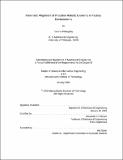Kinematic alignment of precision robotic elements in factory environments
Author(s)
Willoughby, Patrick (Patrick John), 1978-
DownloadFull printable version (4.016Mb)
Other Contributors
Massachusetts Institute of Technology. Dept. of Mechanical Engineering.
Advisor
Alexander H. Slocum.
Terms of use
Metadata
Show full item recordAbstract
In the measurement and instrumentation fields, kinematic couplings have been widely used to create precise and repeatable interfaces on a variety of devices. However, these devices have been limited to low load and clean environments such as in semiconductor manufacturing facilities. While traditional factory environments present less ideal conditions for the implementation of kinematic couplings, the benefits of more repeatable, deterministic interfaces is becoming more necessary as tolerances for products continue to become more stringent. In this thesis, general exact constraint and kinematic coupling design theory is discussed with specific application for use in industrial environments. Factors such as installation and cleanliness are discussed along with traditional design parameters such as Hertzian contact stress and preload. To test out the application of kinematic couplings to detrimental environments, two separate case studies were performed. The first case study consists of a small scale metrology device used to calibrate the home position of the ABB 6400R robot. In this application, a low-load coupling is designed for a less than ideal environment. The second case study applies kinematic coupling theory to the medium scale, high load wrist interface on the same robot. In the latter, two forms of couplings were compared, including the classic ball and groove coupling as a baseline and the three pin coupling as a new, cheap solution. Testing of prototypes of each concept shows potential for inclusion of this technology in future robot models.
Description
Thesis (S.M.)--Massachusetts Institute of Technology, Dept. of Mechanical Engineering, 2002. Includes bibliographical references (p. 85-86). This electronic version was submitted by the student author. The certified thesis is available in the Institute Archives and Special Collections.
Date issued
2002Department
Massachusetts Institute of Technology. Department of Mechanical EngineeringPublisher
Massachusetts Institute of Technology
Keywords
Mechanical Engineering.